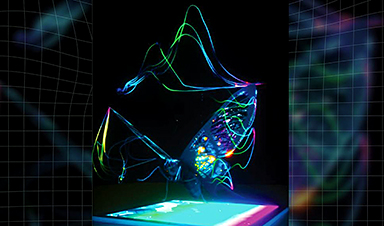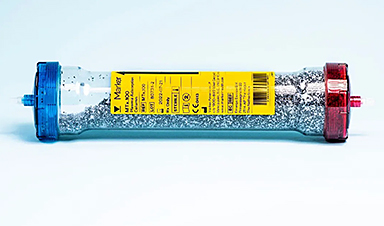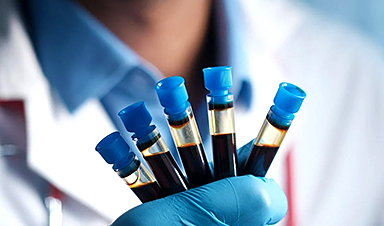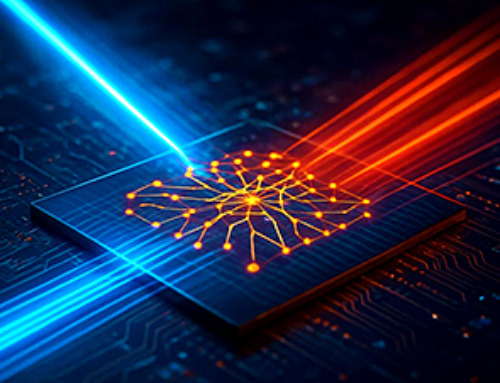There are many creatures on our planet with more advanced senses than humans. Turtles can sense Earth’s magnetic field. Mantis shrimp can detect polarized light. Elephants can hear much lower frequencies than humans can. Butterflies can perceive a broader range of colors, including ultraviolet (UV) light.
This new research, led by University of Illinois Urbana-Champaign electrical and computer engineering professor Viktor Gruev and bioengineering professor Shuming Nie, was recently published in the journal Science Advances.
Small Variations
“We’ve taken inspiration from the visual system of butterflies, who are able to perceive multiple regions in the UV spectrum, and designed a camera that replicates that functionality,” Gruev says. “We did this by using novel perovskite nanocrystals, combined with silicon imaging technology, and this new camera technology can detect multiple UV regions.”
UV light is electromagnetic radiation with wavelengths shorter than that of visible light (but longer than X-rays). We are most familiar with UV radiation from the sun and the dangers it poses to human health. UV light is categorized into three different regions—UVA, UVB and UVC— based on different wavelength ranges. Because humans cannot see UV light, it is challenging to capture UV information, especially discerning the small differences between each region.
Butterflies, however, can see these small variations in the UV spectrum, like humans can see shades of blue and green. Gruev notes, “It is intriguing to me how they are able to see those small variations. UV light is incredibly difficult to capture, it just gets absorbed by everything, and butterflies have managed to do it extremely well.”
The Imitation Game
Humans have trichromatic vision with three photoreceptors, where every color perceived can be made from a combination of red, green and blue. Butterflies, however, have compound eyes, with six (or more) photoreceptor classes with distinct spectral sensitivities. In particular, the Papilio xuthus, a yellow, Asian swallowtail butterfly, has not only blue, green and red, but also violet, ultraviolet and broadband receptors. Further, butterflies have fluorescent pigments that allow them to convert UV light into visible light which can then be easily sensed by their photoreceptors. This allows them to perceive a broader range of colors and details in their environment.
Beyond the increased number of photoreceptors, butterflies also exhibit a unique tiered structure in their photoreceptors. To replicate the UV sensing mechanism of the Papilio xuthus butterfly, the UIUC team has emulated the process by combining a thin layer of PNCs with a tiered array of silicon photodiodes.
PNCs are a class of semiconductor nanocrystals that display unique properties similar to that of quantum dots—changing the size and composition of the particle changes the absorption and emission properties of the material. In the last few years, PNCs have emerged as an interesting material for different sensing applications, such as solar cells and LEDs. PNCs are extremely good at detecting UV (and even lower) wavelengths that traditional silicon detectors are not. In the new imaging sensor, the PNC layer is able to absorb UV photons and re-emit light in the visible (green) spectrum which is then detected by the tiered silicon photodiodes. Processing of these signals allows for mapping and identification of UV signatures.
Health care and beyond
There are various biomedical markers present in cancerous tissues at higher concentrations than in healthy tissues—amino acids (building blocks of proteins), proteins, and enzymes. When excited with UV light, these markers light up and fluoresce in the UV and part of the visible spectrum, in a process called autofluorescence. “Imaging in the UV region has been limited and I would say that has been the biggest roadblock for making scientific progress,” explains Nie. “Now we have come up with this technology where we can image UV light with high sensitivity and can also distinguish small wavelength differences.”
Because cancer and healthy cells have different concentrations of markers and therefore different spectral signatures, the two classes of cells can be differentiated based on their fluorescence in the UV spectrum. The team evaluated their imaging device on its ability to discriminate cancer-related markers and found that is capable of differentiating between cancer and healthy cells with 99% confidence.
Gruev, Nie and their collaborative research team envision being able to use this sensor during surgery. One of the biggest challenges is knowing how much tissue to remove to ensure clear margins and such a sensor can help facilitate the decision-making process when a surgeon is removing a cancerous tumor.
“This new imaging technology is enabling us to differentiate cancerous versus healthy cells and is opening up new and exciting applications beyond just health,” Nie says. There are many other species besides butterflies capable of seeing in the UV, and having a way to detect that light will provide interesting opportunities for biologists to learn more about these species, such as their hunting and mating habits. Bringing the sensor underwater can help bring a greater understanding of that environment as well. While a lot of UV is absorbed by water, there is still enough that makes it through to have an impact and there are many animals underwater that also see and use UV light.
More information: Cheng Chen et al, Bioinspired, vertically stacked, and perovskite nanocrystal–enhanced CMOS imaging sensors for resolving UV spectral signatures, Science Advances (2023). DOI: 10.1126/sciadv.adk3860. www.science.org/doi/10.1126/sciadv.adk3860
Journal information: Science Advances
News
Measles Is Back: Doctors Warn of Dangerous Surge Across the U.S.
Parents are encouraged to contact their pediatrician if their child has been exposed to measles or is showing symptoms. Pediatric infectious disease experts are emphasizing the critical importance of measles vaccination, as the highly [...]
AI at the Speed of Light: How Silicon Photonics Are Reinventing Hardware
A cutting-edge AI acceleration platform powered by light rather than electricity could revolutionize how AI is trained and deployed. Using photonic integrated circuits made from advanced III-V semiconductors, researchers have developed a system that vastly [...]
A Grain of Brain, 523 Million Synapses, Most Complicated Neuroscience Experiment Ever Attempted
A team of over 150 scientists has achieved what once seemed impossible: a complete wiring and activity map of a tiny section of a mammalian brain. This feat, part of the MICrONS Project, rivals [...]
The Secret “Radar” Bacteria Use To Outsmart Their Enemies
A chemical radar allows bacteria to sense and eliminate predators. Investigating how microorganisms communicate deepens our understanding of the complex ecological interactions that shape our environment is an area of key focus for the [...]
Psychologists explore ethical issues associated with human-AI relationships
It's becoming increasingly commonplace for people to develop intimate, long-term relationships with artificial intelligence (AI) technologies. At their extreme, people have "married" their AI companions in non-legally binding ceremonies, and at least two people [...]
When You Lose Weight, Where Does It Actually Go?
Most health professionals lack a clear understanding of how body fat is lost, often subscribing to misconceptions like fat converting to energy or muscle. The truth is, fat is actually broken down into carbon [...]
How Everyday Plastics Quietly Turn Into DNA-Damaging Nanoparticles
The same unique structure that makes plastic so versatile also makes it susceptible to breaking down into harmful micro- and nanoscale particles. The world is saturated with trillions of microscopic and nanoscopic plastic particles, some smaller [...]
AI Outperforms Physicians in Real-World Urgent Care Decisions, Study Finds
The study, conducted at the virtual urgent care clinic Cedars-Sinai Connect in LA, compared recommendations given in about 500 visits of adult patients with relatively common symptoms – respiratory, urinary, eye, vaginal and dental. [...]
Challenging the Big Bang: A Multi-Singularity Origin for the Universe
In a study published in the journal Classical and Quantum Gravity, Dr. Richard Lieu, a physics professor at The University of Alabama in Huntsville (UAH), which is a part of The University of Alabama System, suggests that [...]
New drug restores vision by regenerating retinal nerves
Vision is one of the most crucial human senses, yet over 300 million people worldwide are at risk of vision loss due to various retinal diseases. While recent advancements in retinal disease treatments have [...]
Shingles vaccine cuts dementia risk by 20%, new study shows
A shingles shot may do more than prevent rash — it could help shield the aging brain from dementia, according to a landmark study using real-world data from the UK. A routine vaccine could [...]
AI Predicts Sudden Cardiac Arrest Days Before It Strikes
AI can now predict deadly heart arrhythmias up to two weeks in advance, potentially transforming cardiac care. Artificial intelligence could play a key role in preventing many cases of sudden cardiac death, according to [...]
NanoApps Medical is a Top 20 Feedspot Nanotech Blog
There is an ocean of Nanotechnology news published every day. Feedspot saves us a lot of time and we recommend it. We have been using it since 2018. Feedspot is a freemium online RSS [...]
This Startup Says It Can Clean Your Blood of Microplastics
This is a non-exhaustive list of places microplastics have been found: Mount Everest, the Mariana Trench, Antarctic snow, clouds, plankton, turtles, whales, cattle, birds, tap water, beer, salt, human placentas, semen, breast milk, feces, testicles, [...]
New Blood Test Detects Alzheimer’s and Tracks Its Progression With 92% Accuracy
The new test could help identify which patients are most likely to benefit from new Alzheimer’s drugs. A newly developed blood test for Alzheimer’s disease not only helps confirm the presence of the condition but also [...]
The CDC buried a measles forecast that stressed the need for vaccinations
This story was originally published on ProPublica, a nonprofit newsroom that investigates abuses of power. Sign up to receive our biggest stories as soon as they’re published. ProPublica — Leaders at the Centers for Disease Control and Prevention [...]





















